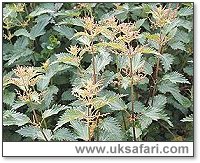
|

|
|
 Sent
to you Sent
to you
by e-mail
|
|
Simply
enter your details and hit the send button
more
info |
|


Click Here

Links
Advertise
Terms of Use
Contributors
About Us
Contact Us
|
 |
Go back
 | Bookmark
| Bookmark
 | Print Page
| Print Page  | E-Mail Us
| E-Mail Us 



Photo: G. Bradley
|
|
UK
Safari Tip:
A great way to see all the details on these plants is with a powerful hand
lens - click
here
|
|
Latin name: Urtica Dioica
Size: Grows to a height of around 150cms.
Distribution: Found throughout the UK.
Flowering months: May to September.
Habitat: Found in woods, waste ground and road verges.
Special features: They distribute themselves quite rapidly, by seeds, and also by means of their creeping roots, which spread out and then send up new shoots.
 The stems and the leaves are covered with tiny, pointed, glass-like stinging hairs. If you touch them, they break off, and penetrate the skin, releasing a complex mixture of chemicals which causes an irritating rash. The stems and the leaves are covered with tiny, pointed, glass-like stinging hairs. If you touch them, they break off, and penetrate the skin, releasing a complex mixture of chemicals which causes an irritating rash.
These stings are designed as a defense mechanism against browsing cattle and rabbits. Some other plants mimic the appearance of stinging nettles, such as the white dead nettle. Although the leaves carry no sting, the look of the leaves is enough to deter most browsing animals.
The Latin name 'dioica' literally means two houses. This is because the male and female flowers are situated on different plants. You can normally tell the sex of a nettle plant during the flowering season. On a female plant the flowers hang down, but on a male plant the flowers stand out.
Although many people dislike them, normally as a result of experiencing a sting, nettles do provide food and shelter for a large number of insects, such as the caterpillars of peacock, comma and tortoiseshell butterflies.

UK Safari Wild Flower Section
UK Safari Plants and Trees Section
|
 |

|